 |
|

|
 |
TABLE of CONTENTS
 |
MnDOT remembers co-workers killed or injured in work zones |
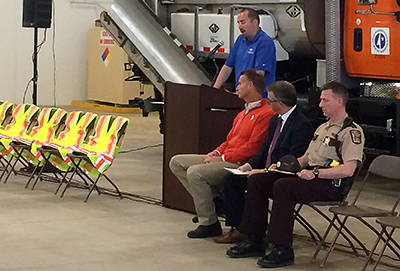
Adam Miller, an assistant highway maintenance supervisor in the Owatonna subarea, talked about MnDOT's work at crash scenes and the roles they play in keeping others safe during the District 6 Worker Memorial Day observance at the Rochester truck station. About 200 people attended the District 6 event. Photo by Anne Meyer |
Throughout the week of April 24, agency staff statewide honored the 34 MnDOT workers and 15 contractors who lost their lives since 1960 while working on Minnesota highways.
Gov. Mark Dayton proclaimed April 28, 2017 as Worker Memorial Day in Minnesota to recognize the high price these transportation workers paid to construct and maintain the state’s transportation system.
In addition, the Interstate 35W bridge in Minneapolis was lit orange April 28 to remember the fallen transportation workers.
“With more than 200 construction work zones underway this year, we have hundreds of men and women working to improve our roads and bridges and make them safer for everybody,” said Commissioner Charlie Zelle. “We need to do our part so all of our workers return safely to their families at the end of the day.”
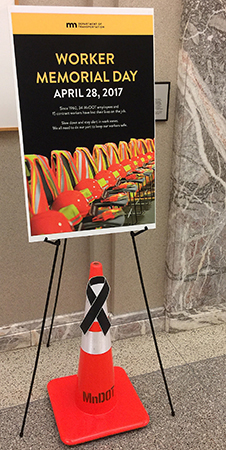
Central Office observed Worker Memorial Day with a poster and orange cone on each floor of the Transportation Building to remind employees of their fallen co-workers. Photo by Rich Kemp |
Mankato
AFSCME Local 280 hosted the Worker Memorial Day observance April 26 in District 7/Mankato, which has held or been part of the event annually since 1994. This year’s event included remarks from District Engineer Greg Ous, Lt. Kevin McDonald and Annette Larson, regional Toward Zero Deaths coordinator. David Albrecht, a maintenance worker from the Le Sueur truck station, read the poem, “These Chairs,” written by Dale Plemmons, former District 7 safety administrator. District 7 employees paused for a moment of silence to remember two of their own fallen workers, Darrell Blackwell and Mike Struck. Blackwell died while performing tractor mowing operations south of Fairfax in 2006, and Struck died while fighting floodwaters near St. Peter in 2011.
Rochester
District 6 hosted a Worker Memorial Day event at the Rochester truck station on April 27, the day Mayor Ardell Brede proclaimed as Worker Memorial Day in Rochester.
“Each year, we gather for a moment to recognize and remember the men and women who have lost their lives while working on Minnesota’s highways,” said Jeff Vlaminck, District 6 transportation engineer. “Our construction season is taking off with many projects started or beginning next week, so this is a timely reminder for everyone to focus on safe driving in work zones.”
Bemidji
In District 2, a Worker Memorial Day display was set up at a construction open house in downtown Bemidji. The display tied information about upcoming construction projects with the need to drive safely in work zones. The display included orange cones and four empty chairs with safety vests and hats; it was moved later to the District 2 headquarters lobby.
Central Office
MnDOT’s Central Office displayed a cone with a black ribbon and a Worker Memorial poster on each floor of the Transportation Building to remind employees of their fallen co-workers.
April 28 has been recognized nationally and locally as Worker Memorial Day since 1989.
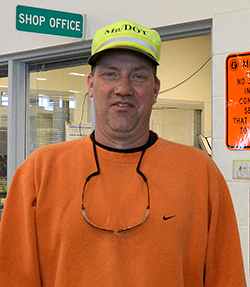
Ron McDeid, Metro District, was injured in a work zone crash in 2014. Photo by Sue Roe
Crash survivors urge drivers to slow down, be alert in work zones
By Sue Roe
MnDOT has survivors to tell the story of the risks of construction and maintenance work and of the importance of work zone safety.
Metro District’s Ron McDeid was injured in a work zone crash June 22, 2014. The 26-year employee of MnDOT was setting cones at Interstate 35W in Burnsville when a distracted driver hit the rear driver’s side of the truck right next to where McDeid was sitting in a crash cage. McDeid suffered back and neck injuries and had a traumatic brain injury. He doesn’t remember the crash, but was told he flew into the air and was knocked out.
His co-worker, Dennis Scott, a nine-year employee, was driving the truck. He doesn’t remember the impact either because he was knocked unconscious, too. When he came to, he got out of the truck to help McDeid.
“I knew it was going to be bad. I walked around the truck and I saw Ron lying face down on the ground, bleeding from his head,” Scott said. “I kept talking to Ron, trying to keep him calm. He was very combative, as often happens with a brain injury, but he kept listening to my voice.”
Both McDeid and Scott were taken by ambulance to the hospital.
McDeid was hospitalized for six weeks and returned to light duty work four months later. He still suffers from those injuries today.
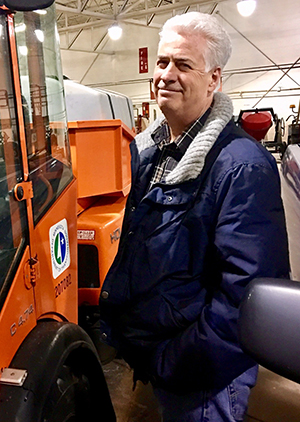
Dennis Scott, Metro District, was injured in the same work zone crash in 2014 as Ron McDeid. He only returned to his transportation generalist job in November 2016, having been assigned light-duty work since the crash. Photo courtesy of Dennis Scott |
Scott ruptured a disk in his neck that required surgery. He was off and on work for two years. He suffers from post-traumatic stress disorder. Last November he got off light-duty work and returned to his transportation generalist job.
“It was hard at first,” Scott said about going back to work on the road. “I just wanted to get back to a normal life, but you don’t have that anymore. It takes a lot to learn how to deal with it.”
McDeid and Scott want to tell their story to help people understand what can happen when someone is driving distracted or decides to speed in a work zone.
“People need to pay attention because it’s not just a vehicle that’s in a crash. It’s a human life and you can change that life forever,” Scott said. “Just slow down. A couple of minutes isn’t going to make a difference one way or the other.”
“When people see orange signs and cones, they should slow down and move over,” McDeid said. “They should stay off their phones and stay back from any work vehicles they see in a work zone.”
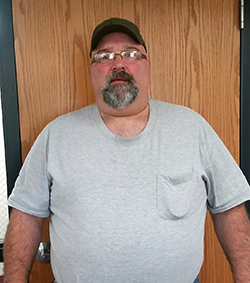
Don Heldt, Metro District, was injured in a work zone crash in February. Photo by Duane Douterack
Don Heldt’s injury happened when he was in the driver’s seat of a parked crash truck protecting workers who were repairing cable barrier on southbound I-35W on Feb. 14, 2017. A distracted driver hit Heldt’s truck, which was parked on the shoulder.
At the time, Heldt, also a Metro District employee, was looking in the median ditch and didn’t see the car coming. The truck was pushed forward and the cushion trailer, designed to absorb the energy of an impact, was destroyed. The two other crash trucks also at the work zone turned around and drove back to protect Heldt and keep other cars from hitting crash debris.
Heldt’s injuries kept him off work for three weeks. He’s now on light duty work.
“There’s not a day that goes by that I don’t see someone driving or at a stop sign with a phone,” Heldt said. “I’ve been in a work zone where a driver hit five cones. He was going so fast that we couldn’t get a plate number. People die out there because of careless driving.”
Heldt said people should stay off their phones, slow down and be patient.
“There’s nothing that important on a phone that it can’t wait,” he said.
|
|

|
 |
TABLE of CONTENTS
 |
Regional TZD workshop combines knowledge from field experts |
|
A simulator courtesy of Southwest EMS demonstrated the dangers to a vehicle's occupants in a roll-over crash. The simulator demo was just one of several hands-on breakout sessions at the April 21 Toward Zero Deaths workshop in Redwood Falls. Video by Kristine Hernandez |
Traffic safety stakeholders from across southwest Minnesota attended a regional Toward Zero Deaths workshop April 21 in Redwood Falls. The nearly 100 participants included MnDOT employees, local Minnesota State Patrol members, firefighters, and city and county staff.
District 8 Engineer Jon Huseby opened the workshop with an overview of TZD’s cornerstone ‘E’s. In past years, TZD has recognized four ‘E’s: enforcement, engineering, education and outreach, and emergency medical and trauma services. The program now recognizes a fifth ‘E,’ everyone else—including the general public, legislators and media.
Sgt. Troy Christianson from the Minnesota State Patrol discussed recent statistics and trends in traffic crashes. Highlights included addressing the ‘big four’ issues the southwest continues to struggle with: impairment, distraction, seat belt use and speed. Christianson noted that traffic fatalities statewide have leveled off after years of steady decline.
Kristin Loobeek, social media coordinator, explained how MnDOT is using social media to reinvigorate standard traffic safety messages. One such method is the use of electronic highway message boards to share TZD’s ‘Message Monday,’ which uses humor or rhymes to convey safety messages.
Breakout sessions included a roll-over simulator courtesy of Southwest EMS. The main display incorporated a full-size pickup cab that rotates side over side. EMS staff explained that unbelted dummy demonstrations are a jolting but effective tool while talking about traffic safety with high school students. Attendees also had the opportunity to navigate a cone course in a pedal cart with ‘drunk goggles’ on. Despite the chuckles from participants and those watching, the somber real life implications of swerving and quick corrections while driving loomed over the group.
Additional sessions included an overview of the critical incident stress reactions in first responders. Attendees learned how to recognize and mediate intense stress in themselves and others after traumatic events. Participants were also presented with the jarring similarities of drunk and drowsy driving. Jarad Ripperger from the Sleep Center of Willmar explained how sleep disorders and chronic disease play a key part in drowsy driving. The workshop concluded with a personal impact presentation from Gina Calistro, whose father died from injuries after a crash caused by a drunk driver.
Upcoming TZD workshops:
- West Central, May 11 in Ottertail
- Northwest, May 23 in Bemidji
- East Central, May 24 in Brainerd
- Northeast, May 31 in Duluth
|
 |
|

|
 |
TABLE of CONTENTS
 |
District 3 opens new Little Falls truck station |
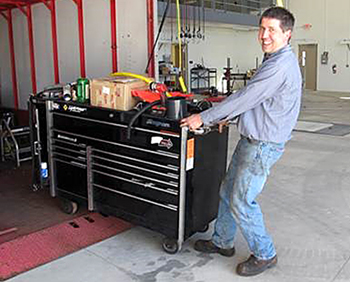
David Geise, heavy equipment mechanic, unpacks his tool box April 17 in the repair shop bay of the new Little Falls Truck Station. Photo by Jenny Seelen |
The newly constructed Little Falls truck station/subarea facility opened for business April 19.
The $6.8 million facility is designed to house and maintain today’s larger, modern plow trucks and equipment. Its new location, just northwest of the Hwy 10/Hwy 371 split in Little Falls, will also reduce response times to the area’s higher volume roads and improve overall operational efficiency.
“Now that we have relocated, only one plow truck will go through downtown Little Falls and cross a busy railroad track during snow and ice operations, which will increase safety and efficiency,” said Todd Fussy, Little Falls subarea supervisor. “Being in the central part of the state will also help with sharing equipment resources.”
The main building is 24,000 square feet and includes three mechanic repair bays, one wash bay, brine making facility, inventory and shop storage areas to house plow trucks, along with an employee support area.
The facility provides regional support for de-icing chemicals, shared fleet and mechanic services, and includes a large free-standing cold storage building for equipment and supplies. Equipment includes 10 plow trucks, one loader, two pick-up trucks, one skid steer and one tractor. |
 |
|

|
 |
TABLE of CONTENTS
 |
District 1 staff work with Duluth city crews to clear drains |
|
By Rich Kemp
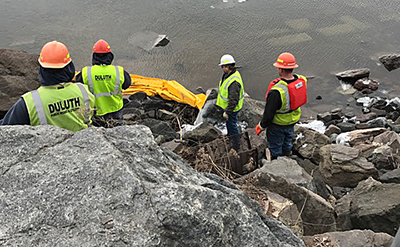
MnDOT and Duluth city crews worked together to clear drains that were causing flooding on Interstate 35. Photo courtesy of District 1 |
After plugged freeway drains caused flooding of the southbound Interstate 35 exit ramp to Lake Avenue and 5th Avenue, crews from MnDOT and the city of Duluth went to work March 6 to clear the drains and stop the flooding.
The drains were plugged when waves crashing in from Lake Superior filled the drains with beach rock.
“Wave action cast softball sized rocks nearly 300 feet up into the drain and completely filled the pipe to within 50 or so feet of the outfall,” said Chris Cheney, District 1 maintenance supervisor. “This caused flooding on the freeway from snow melt and spring rains.”
MnDOT and city crews coordinated efforts to clean the drain that was flooding the ramp.
“It was a collaborative effort with the city,” said Cheney. “The Duluth city crews did a great job cleaning the drain in the icy waters and the District 1 Carlton Bridge crew built and installed the outfall protection system.”
Steve Baublitz, Duluth subarea supervisor, worked closely with the Duluth city crews and coordinated needs from his MnDOT crews.
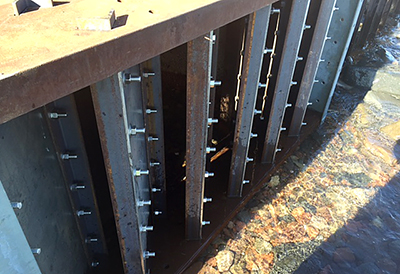
The District 1 bridge crew installed an outfall protection system on a drain in Duluth. Dave Mohar, District 1 hydraulics engineer, designed the system to prevent rocks from plugging the drains. Photo courtesy of District 1 |
Dave Mohar, District 1 hydraulics engineer, designed the outfall protection system to prevent the rocks from plugging the drains. The bridge crew installed the system on one of the three affected drains.
With back to back spring storms, there were big waves on the lake. Cheney said the outfall protections system seemed to be deflecting the wave action effectively.
“Once it calms down, we can see how much rock was cast into the outfall,” he said. “We will continue our efforts to finish cleaning the other two drains and installing protection systems as soon as the weather allows.”
“I hesitate to start thanking anyone for their work on the project because there were so many people who helped,” said Cheney. “It was a successful cooperative project.” |
 |
|

|
|

|
|

|
 |
TABLE of CONTENTS
 |
Conference highlights rules, tools for changing environments |
By Judy Jacobs
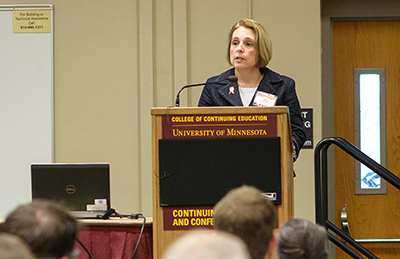
Lynn Clarkowski, Office of Environmental Stewardship director, welcomes participants to the 2017 conference. Photo by David Gonzalez |
Nearly 300 people attended the semi-annual Environmental Stewardship Conference, Rules and Tools for Changing Environments, sponsored by the Office of Environmental Stewardship on April 19. Participants included representatives from MnDOT offices and districts statewide, local governments, state and federal agencies, and consulting firms.
“We are excited to offer a wide variety of sessions designed to educate and inform about evolving technology, community involvement and changing policies,” said Lynn Clarkowski, Office of Environmental Stewardship director. “From forecasting to planning, design and construction to project completion, every aspect of our work is affected by changes around us.”
Commissioner Charlie Zelle provided opening comments to the group.
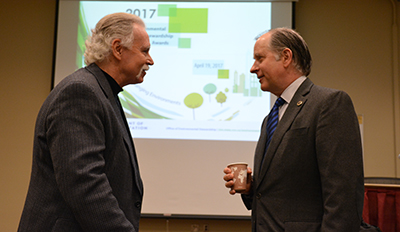
At left, Scott Bradley, director, Context Sensitive Solutions, Office of Environmental Stewardship, visits with Commissioner Charlie Zelle before the conference begins. Photo by Judy Jacobs |
“This conference is guided by MnDOT’s vision that Minnesota’s multimodal transportation system maximizes the health of people, the environment and our economy,” Zelle said. “It reflects MnDOT’s commitment to provide the best and most useful information to all who are involved in the delivery of transportation projects.”
Keynote speaker, Shari Schaftlein, Federal Highway Administration, presented information about current issues in the Office of Human Environment and national initiatives emerging from the new administration.
Breakout sessions, conducted by U.S. Fish and Wildlife Service, FHWA and MnDOT staff, addressed important environmental concerns, such as protected species, how drones can be used for the environment, new Programmatic Categorical Exclusion agreements, public engagement and environmental ethics. The conference also provided an opportunity to honor projects and people who demonstrate exemplary environmental performance.
The next Environmental Stewardship Conference will be held in spring 2019.
Earth Day 2017: Employees challenged by earth friendly trivia
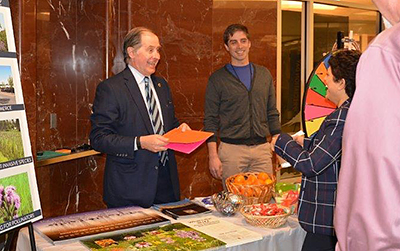 In observance of Earth Day on April 22, MnDOT Senior Leadership and the Office of Environmental Stewardship hosted an “Earth or Consequences” trivia game at Central Office. Visitors were invited to spin the trivia wheel and answer an earth friendly question to win a prize. Commissioner Charlie Zelle and Tim Sexton, construction and operations director, Office of Environmental Stewardship, helped staff the booth. Photo by Judy Jacobs In observance of Earth Day on April 22, MnDOT Senior Leadership and the Office of Environmental Stewardship hosted an “Earth or Consequences” trivia game at Central Office. Visitors were invited to spin the trivia wheel and answer an earth friendly question to win a prize. Commissioner Charlie Zelle and Tim Sexton, construction and operations director, Office of Environmental Stewardship, helped staff the booth. Photo by Judy Jacobs
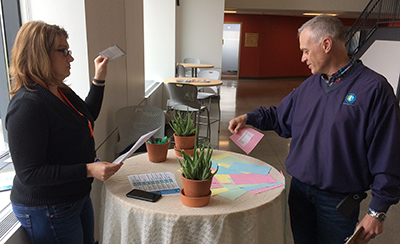
Nathan Gregor, District 6 natural resources manager, participated in the “Earth or Consequences” trivia game in Rochester by answering questions posed by Anne Meyer, District 6 public affairs. Photo by Mike Dougherty
|
|
 |
|

|
 |
TABLE of CONTENTS
 |
Parklet to help agency staff engage with public at community events, about road projects, plans |
By Jasna Hadzic-Stanek

MnDOT’s 18-foot by 6-foot parklet debuted at the 2016 Minnesota State Fair. It includes seating areas and plantings. Employees interested in reserving a parklet for use in their districts can email COParklet.DOT@state.mn.us. Photo by Jasna Hadzic-Stanek |
In communities across the state, tiny, portable public parks are popping up in places where parking spots used to be. These simple and economical parks are called parklets and the Modal Planning and Program Management Division is hoping people will soon start to see more of them.
By definition, a parklet is a sidewalk extension that provides more space and amenities for people using the street. They are a cost-effective way to add public gathering spaces to public streets.
MnDOT owns one parklet, an 18-foot by 6-foot wood bench and planters set-up, that was used last summer at the State Fair Eco Experience Kick Gas booth.
Central Office employees can visit and use the parklet, which will be set up on John Ireland Boulevard May 8. Staff will be available over the lunch hour to answer questions. The parklet will be on display until May 19.
Districts can reserve the MnDOT parklet for temporary use to engage with the public on upcoming road construction projects/plans and community events.
For more information, email COParklet.DOT@state.mn.us. To see the dates the parklet is available in Outlook, go to *DOT_CO Parklet.
“During the public engagement process with Minnesota Walks, people said they wanted to see development of streets that are public spaces that foster social and economic activity,” said Tim Henkel, Modal Planning and Program Management Division assistant commissioner. “Parklets are one strategy we can use to promote and encourage the development of walkable communities.”
He said parklets engage the community and generate interest in the public realm. They also transform underused street space into public spaces that support local businesses.
Parklets are easily assembled and can be transported with a trailer and pickup. MnDOT’s parklet design uses two bolts and three screws.
The Twin Cities Metro Area and the city of Duluth also use parklets.
They are generally used between May and October and take up one or two parking spaces. They are used on main streets and downtown areas where speed limits are 30 miles per hour and less.
Parklets can include seating, plantings, bike parking and public art.
MnDOT is developing standards that will be integrated into its Right of Way manual for local communities that want to install a parklet on state roads.
For more information on parklets, go to www.minnesotawalks.org. |
 |
|

|
|

|
|

|
 |
TABLE of CONTENTS
 |
Thanks to winter maintenance crews – doing their best work in the worst of weather conditions |
By Jody Martinson, assistant commissioner, Operations Division
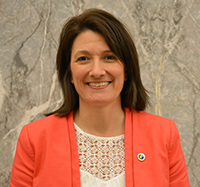
No stranger to winter maintenance operations, Jody Martinson, formerly District 4 transportation engineer, is the new assistant commissioner for the Operations Division. Photo by Rich Kemp |
Some parts of Minnesota had snow and ice this week. That’s certainly not unheard of this time of year in our state, but for the most part, MnDOT can happily say winter is behind us. With that, we want to take the opportunity to acknowledge and thank the maintenance employees who tackled the conditions winter brought us this year. Their skill, expertise and dedication in keeping roads safe for the traveling public are appreciated by us all.
Winter got off to a rather slow start, but by mid-November crews were fighting double-digit snowfalls to the north along with compaction issues on the roads. Other areas of the state brought blizzard conditions and ice. Ice storms, in particular, are extra challenging and require a lot of resources. Our 1,500 snow fighters were always ready for the challenge.
We are fortunate in Minnesota and at MnDOT to have highly trained professionals whom we depend on to clear the roads. Their efforts make it so we can travel to work, move goods and products to market in a timely manner and get to our other destinations.
In January, the American Highway Users Alliance, a national organization comprised of nonprofits and companies that care about highway safety, came to MnDOT to help host its first Snow Fighter Appreciation Day. The alliance was looking for a state that does things right when it comes to fighting snow. Experts pointed the alliance to MnDOT.
We already know our maintenance crews have what it takes to manage each storm, no matter how challenging, in a way that helps keep the traveling public safe.
Our crews know how to operate sophisticated equipment and technology that assists them in clearing the roads. New this winter, approximately 200 snowplows had cameras installed. The public could view the images on 511. MnDOT remains a leader in developing and using snow fighting technology.
Snow removal is often difficult and stressful for our crews. They work long hours and often don’t get the thanks they deserve. Our snow fighters navigate their routes with expertise, but also by experience. They know their routes so well they can tell you where the next guardrail is and what’s over the next hill.
Our drivers save lives and prevent others from being in danger. They clear the way so an ambulance can get to the hospital or so the State Patrol can get to a crash. They rescue stranded motorists. All this is done in the worst of weather conditions.
If you talk to a snowplow operator, you’ll learn they love their jobs. They love the satisfaction and sense of accomplishment in clearing a road. They enjoy seeing the snow roll off the plow blade. They love doing their part to keep the public safe.
Remember that our own safety is just as important as keeping the public safe. Each one of us has the responsibility to perform our job safely so we can go home to our family and friends at the end of the day.
MnDOT is extremely proud of the work the winter maintenance crews do. They do their best work in the most difficult times. Thank you, snow fighters! |
 |
|
| |
|



